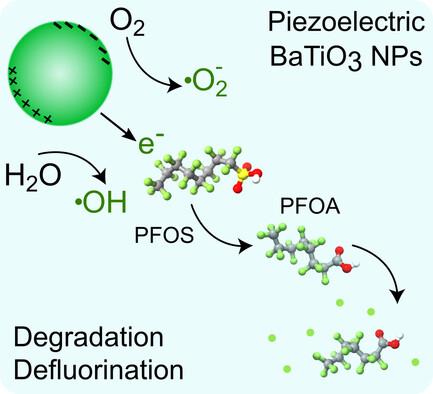Breaking the Perfluorooctane Sulfonate Chain: Piezocatalytic Decomposition of PFOS Using BaTiO3 Nanoparticles
IF 11.1
Q1 MATERIALS SCIENCE, MULTIDISCIPLINARY
引用次数: 0
Abstract
Per- and polyfluoroalkyl substances (PFAS) pose significant environmental and health risks due to their ubiquitous presence and persistence in water systems. Herein, the efficacy of piezocatalysis using barium titanate nanoparticles under ultrasound irradiation for the degradation and defluorination of perfluorooctane sulfonate (PFOS) in water is investigated. The research demonstrates a substantial 90.5% degradation and 29% defluorination of PFOS after 6 h of treatment, highlighting the potential of piezocatalysis as a promising approach for PFAS degradation. Additionally, the quantification of degradation products elucidates the transformation pathways of PFOS, suggesting a stepwise chain-shortening mechanism. The findings underscore the importance of continued research in optimizing piezocatalytic processes and exploring synergistic approaches with other advanced oxidation methods to effectively address PFAS contamination challenges. These efforts are essential for advancing sustainable water treatment strategies and mitigating the environmental and health hazards associated with PFAS contamination.

打破全氟辛烷磺酸链:使用 BaTiO3 纳米粒子压电催化分解全氟辛烷磺酸
全氟和多氟烷基物质(PFAS)在水系统中无处不在且具有持久性,对环境和健康构成了重大风险。本文研究了在超声辐照下使用钛酸钡纳米粒子进行压电催化降解和脱氟处理水中全氟辛烷磺酸(PFOS)的功效。研究表明,经过 6 小时的处理,全氟辛烷磺酸的降解率和脱氟率分别达到了 90.5% 和 29%,凸显了压电催化作为一种降解全氟辛烷磺酸方法的潜力。此外,降解产物的定量分析阐明了全氟辛烷磺酸的转化途径,提示了一种逐步缩短链的机制。这些发现强调了继续研究优化压电催化过程和探索与其他高级氧化方法协同作用的重要性,以有效应对全氟辛烷磺酸污染的挑战。这些努力对于推进可持续水处理战略和减轻与 PFAS 污染相关的环境和健康危害至关重要。
本文章由计算机程序翻译,如有差异,请以英文原文为准。
求助全文
约1分钟内获得全文
求助全文
来源期刊
CiteScore
14.00
自引率
2.40%
发文量
0
期刊介绍:
Small Science is a premium multidisciplinary open access journal dedicated to publishing impactful research from all areas of nanoscience and nanotechnology. It features interdisciplinary original research and focused review articles on relevant topics. The journal covers design, characterization, mechanism, technology, and application of micro-/nanoscale structures and systems in various fields including physics, chemistry, materials science, engineering, environmental science, life science, biology, and medicine. It welcomes innovative interdisciplinary research and its readership includes professionals from academia and industry in fields such as chemistry, physics, materials science, biology, engineering, and environmental and analytical science. Small Science is indexed and abstracted in CAS, DOAJ, Clarivate Analytics, ProQuest Central, Publicly Available Content Database, Science Database, SCOPUS, and Web of Science.

 求助内容:
求助内容: 应助结果提醒方式:
应助结果提醒方式:


